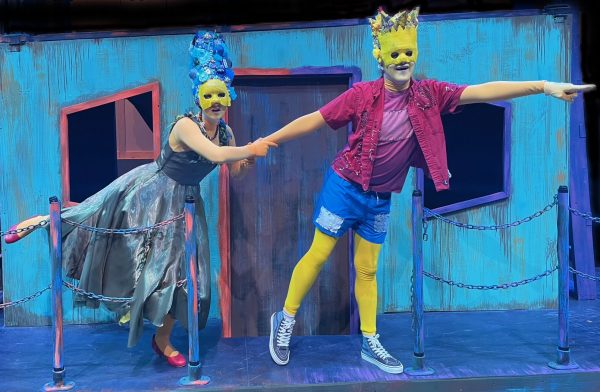
The show “The Simpsons” is a pop culture pièce de résistance. The long-running show’s ability to piece together the flotsam of the cultural zeitgeist so effortlessly has lent it critical acclaim and a spot in the memories of countless watchers. This core facet of “The Simpsons” is what makes its usage in the production “Mr. Burns: A Post-Electric Play” so brilliant.
“Mr. Burns” premiered on Tuesday as part of Tulane University’s Department of Theatre & Dance’s spring season. The play, written by Anne Washburn, envisions a post-apocalyptic world where survivors recreate an episode of “The Simpsons” amongst the rubble.
This unique premise resonates with the audience as we, too, have experienced conversational games of telephone, struggling to remember the exact details of cultural phenomenons — albeit under rosier circumstances. The exact episode being recalled is “Cape Feare,” one that sees the Simpson family uproot their lives in Springfield to escape the murderous intentions of Sideshow Bob. Similarly, the characters in “Mr. Burns” must adapt to a new life, one that is bleaker and more barren than before.
With each act, the play’s timeline jumps forward. The first follows the six survivors shortly after an apocalyptic event as they try to find laughter in their grim situation. The second act places these characters seven years in the future, traveling the ruins of the country as a theater group that exclusively performs episodes of “The Simpsons.” The third and final act takes place 75 years later and features a different cast of characters performing their wildly altered adaptation of “Cape Feare.”
Tension fills the air in each act. Quarrels break out amongst characters, hostile marauders stalk the land and fears of radiation poisoning hang over everyone’s head. The performances of Sydney Schneider, Nya Phillips, Simon Rucker, Ben Longo, Katie Spartz, Madi Bell and Ian Faul — who is also a co-editor of The Hullabaloo’s Arcade section — stand out; their inflections and body language perfectly capture this sense of dread. The set design in “Mr. Burns” also succeeds in achieving this mood, the third act in particular. The viewer sees a warped reality, one with rotted wood, chipped paint and tattered rags.
Yet, the ethos of the play lies in its source material. Aside from “The Simpsons,” the characters riff off antiquated media such as “Seinfeld,” “The Flintstones” and Britney Spears’s “Toxic.” As such, the play is essentially an amalgamation of culture. The rituals of the dystopian society fuse with the ghosts of pre-apocalyptic traditions, creating a bastardized way of life that exists in limbo between imagined fantasy and perceived reality. Schneider summed up the evolution of society’s customs: “Over the course of almost a century, things kind of meshed together.”
This could very well be a view into our distant future.
“Mr. Burns: A Post-Electric Play” plays in the Lupin Theater from March 12 to 17.



Leave a Comment